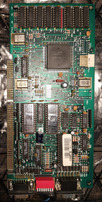waterbeesje wrote on 2021-03-12, 13:53:Last week I made an offer on this unknown, untested graphics card. I can't really find anything on the net about it. […]
Show full quote
Last week I made an offer on this unknown, untested graphics card. I can't really find anything on the net about it.
Some specs:
- main chip: VTCL 27-0842-00
(What brand is this?)
- 2x AMI VGA BIOS, one high, one low
- 1x EPROM labeled L286-2 CIJB
- 8x ram chip: Sharp LH2464-12
- Both EGA And VGA connectors
- 8 dip switches (unknown functions)
I haven't tested it yet, but will do so soon, possibly this weekend. I guess I'll have to tinker with the dip switches a bit 😀
I don't expect too much of it. Something in the league of my Trident 8900B or C&T82C451. It just caught my attention because there don't seem too much information on it.
Do you recognize this card? Can you identify it? Would it perform above slide show level?
This card does not have an integrated clock synthesizer chip, but discrete crystals. It has the two standard VGA crystals ~25MHz and ~28MHz, as well as the standard EGA/MDA crystal of 16.257MHz, and it might take the CGA dot clock (14.318 MHz) from the ISA bus. There are obviously no super-EGA/super-VGA clocks present on this card. This looks like an early 16-bit multi-standard VGA card. Cards like this were common around 1990. The usual specs are: NMI-assisted hardware compatibility with MDA/CGA/EGA/VGA, but you need proprietary BIOS calls to enable the backwards compatibility modes. The switches can be used to choose the monitor type and possibly the initial compatibility mode. Some of the cards allow configurations like "VGA monitor connected, boot up in CGA backwards compatibility mode".
As this card has a 16-bit bus interface and 16-bit BIOS, it is likely faster than the original 8-bit IBM VGA card. Your guess that this card might be comparable to the TVGA8900B is quite good, I would expect the same performance level. It depends on the game whether this performance (up to 1.5MB/s) is slide-show level or better.
The chip with the L286 label is not an EPROM, that chip is the RAMDAC. The label is the type and serial number of the card, not the contents of that chip. The RAMDAC is just a convenient place to put that label. If you are lucky, the BIOS contents help you identify which utilities you need to switch modes. Otherwise, this stuff can usually determined by reverse engineering the BIOS, given enough time and skill.
